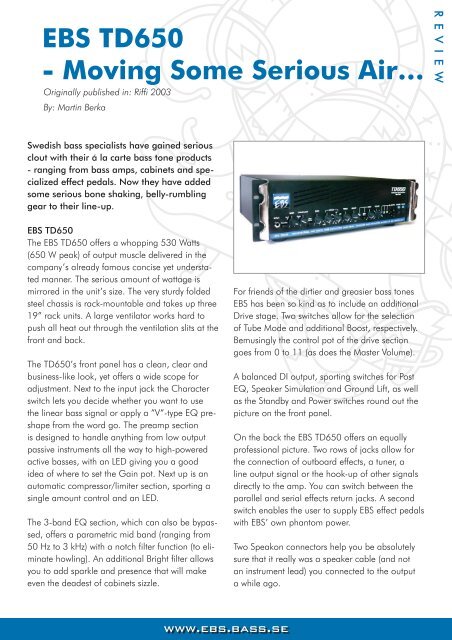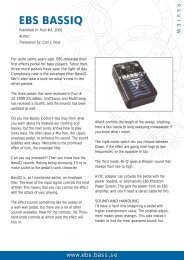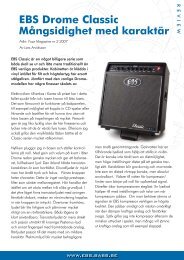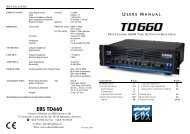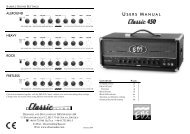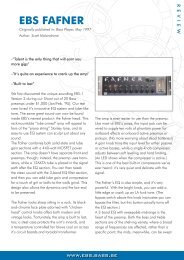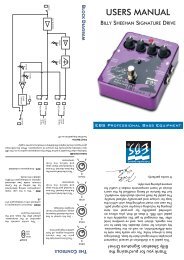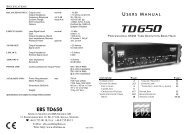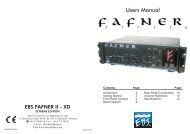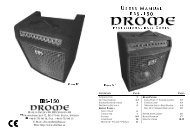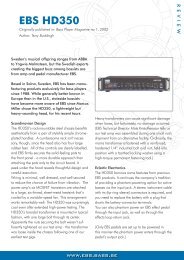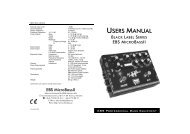TD 650 RIFFI 2003.indd - EBS
TD 650 RIFFI 2003.indd - EBS
TD 650 RIFFI 2003.indd - EBS
You also want an ePaper? Increase the reach of your titles
YUMPU automatically turns print PDFs into web optimized ePapers that Google loves.
<strong>EBS</strong> <strong>TD</strong><strong>650</strong><br />
- Moving Some Serious Air…<br />
Originally published in: Riffi 2003<br />
By: Martin Berka<br />
REVIEW<br />
Swedish bass specialists have gained serious<br />
clout with their á la carte bass tone products<br />
- ranging from bass amps, cabinets and specialized<br />
effect pedals. Now they have added<br />
some serious bone shaking, belly-rumbling<br />
gear to their line-up.<br />
<strong>EBS</strong> <strong>TD</strong><strong>650</strong><br />
The <strong>EBS</strong> <strong>TD</strong><strong>650</strong> offers a whopping 530 Watts<br />
(<strong>650</strong> W peak) of output muscle delivered in the<br />
company’s already famous concise yet understated<br />
manner. The serious amount of wattage is<br />
mirrored in the unit’s size. The very sturdy folded<br />
steel chassis is rack-mountable and takes up three<br />
19” rack units. A large ventilator works hard to<br />
push all heat out through the ventilation slits at the<br />
front and back.<br />
The <strong>TD</strong><strong>650</strong>’s front panel has a clean, clear and<br />
business-like look, yet offers a wide scope for<br />
adjustment. Next to the input jack the Character<br />
switch lets you decide whether you want to use<br />
the linear bass signal or apply a ”V”-type EQ preshape<br />
from the word go. The preamp section<br />
is designed to handle anything from low output<br />
passive instruments all the way to high-powered<br />
active basses, with an LED giving you a good<br />
idea of where to set the Gain pot. Next up is an<br />
automatic compressor/limiter section, sporting a<br />
single amount control and an LED.<br />
The 3-band EQ section, which can also be bypassed,<br />
offers a parametric mid band (ranging from<br />
50 Hz to 3 kHz) with a notch filter function (to eliminate<br />
howling). An additional Bright filter allows<br />
you to add sparkle and presence that will make<br />
even the deadest of cabinets sizzle.<br />
For friends of the dirtier and greasier bass tones<br />
<strong>EBS</strong> has been so kind as to include an additional<br />
Drive stage. Two switches allow for the selection<br />
of Tube Mode and additional Boost, respectively.<br />
Bemusingly the control pot of the drive section<br />
goes from 0 to 11 (as does the Master Volume).<br />
A balanced DI output, sporting switches for Post<br />
EQ, Speaker Simulation and Ground Lift, as well<br />
as the Standby and Power switches round out the<br />
picture on the front panel.<br />
On the back the <strong>EBS</strong> <strong>TD</strong><strong>650</strong> offers an equally<br />
professional picture. Two rows of jacks allow for<br />
the connection of outboard effects, a tuner, a<br />
line output signal or the hook-up of other signals<br />
directly to the amp. You can switch between the<br />
parallel and serial effects return jacks. A second<br />
switch enables the user to supply <strong>EBS</strong> effect pedals<br />
with <strong>EBS</strong>’ own phantom power.<br />
Two Speakon connectors help you be absolutely<br />
sure that it really was a speaker cable (and not<br />
an instrument lead) you connected to the output<br />
a while ago.<br />
www.ebs.bass.se
<strong>EBS</strong> 212 Evolution Pro Line 2000<br />
To go along with an amp of this class you naturally<br />
need a cabinet that can withstand such punishment.<br />
<strong>EBS</strong> has supplied us with a cabinet from<br />
their Evolution Pro Line 2000 series - the 212.<br />
The Evolution Pro Line 2000 212 is meant to<br />
stomach up to 400 W without damage and actually<br />
features a 2” titanium tweeter in addition<br />
to the pair of 12” speakers. A level control on<br />
the cabinet’s back lets you set the tweeter’s level<br />
to your requirements - from ”off” to + 3dB<br />
boost. The front-ported cabinet is put together<br />
from 13-ply Finnish birch and coated in a carpetlike<br />
felt material that <strong>EBS</strong> claim is resistant to<br />
most gigging musician’s environmental hazards -<br />
cigarettes, wine and beer - as well as the usual<br />
tear and wear of schlepping stuff around. Two<br />
sturdy metal side handles give you a good grip on<br />
the 212, even though it really is a serious piece<br />
of furniture. A hand-woven (!) metal grille protects<br />
the speakers adequately and rounds out the classy<br />
picture.<br />
How it Sounds<br />
The <strong>EBS</strong> <strong>TD</strong><strong>650</strong> head offers a wide scope of allout<br />
pro tones and sensible, no-nonsense features.<br />
Take the Character switch, for example, that gives<br />
you the instant ”loudness”-type tone that many<br />
slappers crave - pushing both the bass and the<br />
treble. The compressor works very discretely and<br />
doesn’t audibly color your tone; its role is more<br />
a protective one, to smooth over peaks and transients<br />
that might overload other pre-amp stages<br />
later down the signal chain, rather than audibly<br />
squash and thicken the tone.<br />
The EQ works terrific; the option to use the mid<br />
filter in notch filter mode is so brilliant, you wonder<br />
why it isn’t featured regularly on other amplifiers,<br />
and will come in dead handy if you’re using semiacoustic<br />
bass guitars on-stage in a large set-up.<br />
The Bright filter has enough presence boost to<br />
make your glasses shatter. Really dull cabinets will<br />
no doubt benefit from the Bright function, but<br />
used in conjunction with tweeter-equipped modern<br />
cabinets such as the Pro Line 2000 series it only<br />
adds oozes of unwanted hiss.<br />
<strong>EBS</strong> <strong>TD</strong><strong>650</strong> Tube Definition Bass Head<br />
- 530 W (<strong>650</strong> W peak) output<br />
- Built-in compressor<br />
- 3-band EQ with parametric mids (50 Hz - 3 kHz)<br />
- Active Bright control<br />
- Built-in overdrive section - switchable Transistor/Tube modes,<br />
additional Boost switch<br />
- Pre-shape Character switch<br />
- Balanced XLR DI output - switches for Ground Lift,<br />
Speaker Simulation, Post EQ Output<br />
- 3 RU height<br />
- <strong>EBS</strong> Phantom Power (9V) for direct supply to <strong>EBS</strong> floor effects<br />
- Effect loop with separate parallel and serial return jacks<br />
- Connectors for Instrument (1/4” jack, front), DI Output (XLR),<br />
Effects Loop Send (1/4” jack) and Returns (2 x 1/4” jack), Tuner Out,<br />
- Line Out, Amp Input (all 1/4” jack), Speaker Out (2 x Speakon),<br />
Mains (IEC with fuse holder)<br />
www.ebs.bass.se
The Drive section is the place where the real fun<br />
can be had. The settings of the Drive control greatly<br />
affect the color of the tone. At ”0” in Transistor<br />
mode the tones are the cleanest and clearest.<br />
Turning the control up towards ”12 o’clock” adds<br />
more volume, a slight bit of compression and a<br />
distinctive amount of saturated coloration - you<br />
add juice and beef to your bass tone. From about<br />
”11 o’clock” onwards (depending on the instrument<br />
you use) Drive starts to add clearly audible<br />
grainy-ness to proceedings, until it really overdrives<br />
and distorts. Tube mode isn’t drastically different<br />
in its delivery; it simply has a slightly looser<br />
basic tone (especially in the lower mid register).<br />
Boost Drive does what it says on the tin - it applies<br />
a level booster before the drive section upping the<br />
gain/overdrive structure.<br />
The balanced DI output works fine, even if I<br />
couldn’t make out much of an effect in using the<br />
Speaker Simulation.<br />
One thing I would like to see added to the already<br />
tasteful menu, that is the <strong>TD</strong><strong>650</strong>, would be footswitch-controllability<br />
for some of the functions,<br />
namely Character, Filter Bypass, Tube Mode and<br />
Drive Boost. If one were able to use a footswitch<br />
to toggle these functions on and off, it would<br />
enhance the on-stage usefulness of this great amp<br />
head even further.<br />
The <strong>EBS</strong> Pro Line 2000 212 cabinet fits the <strong>TD</strong><strong>650</strong><br />
head like a glove. It is beautiful to look at, build<br />
for the road and has a modern and open tonal<br />
characteristic. I found that in conjunction with the<br />
<strong>TD</strong><strong>650</strong> I could easily get great, dynamic bass<br />
tones. In this set-up I found I could get enough<br />
top end even with the tweeter turned off. For<br />
more refined, Hi-Fi tones the tweeter still comes<br />
in handy and offers more than enough scope for<br />
tonal adjustment. Build-wise the 212 is solid like<br />
a rock - the cabinet was about the only thing not<br />
rattling when I test drove this combination.<br />
Summary<br />
What can I say Again the Swedish bass buffs<br />
from <strong>EBS</strong> have fulfilled their aim to produce topclass<br />
bass amplification. The <strong>TD</strong><strong>650</strong> is a very<br />
serious tool for the bassist who demands serious<br />
volume and tonal flexibility. The Pro Line 2000<br />
212 cabinet is a cabinet for all playing styles with<br />
excellent power handling, an open and dynamic<br />
sound and a classy styling built to last the whole<br />
distance.<br />
<strong>EBS</strong> Evolution Pro Line 2000 212 cabinet<br />
- Takes up to 400 W (800 W peak) at 4 Ohms<br />
- Two 12” speakers plus one 2” tweeter (with separate Level control)<br />
- Felt-/Carpet-type covered 13-ply Finnish birch cabinet<br />
- Plastic corner protectors<br />
- Metal front grille (hand woven)<br />
- Speakon connectors for Link and Input<br />
www.ebs.bass.se


